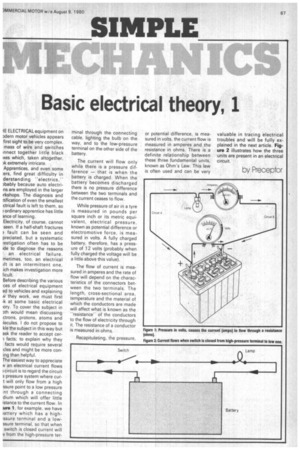Basic electrical theory, 1
Page 69

If you've noticed an error in this article please click here to report it so we can fix it.
iE ELECTRICAL equipment on Ddern motor vehicles appears first sight to be very complex. mass of wire and switches innect together little black ixes which, taken altogether, )I( extremely intricate.
Apprentices, and even some :ers, find great difficulty in derstanding "electrics,Dbably because auto electrins are employed in the larger irkshops. The diagnosis and ;tification of even the smallest ctrical fault is left to them, so ordinary apprentice has little 3nce of learning.
Electricity, of course, cannot seen. If a half-shaft fractures 3 fault can be seen and preciated, but a systematic restigation often has to be ide to diagnose the reasons • an electrical failure. metimes, too, an electrical Jlt is an intermittent one, ich makes investigation more ficult.
Before describing the various .ces of electrical equipment ed to vehicles and explaining
N they work, we must first ik at some paste electrical
iory. To cover the subiect in Dth would mean discussing ctrons, protons, atoms and ilecules. I do not propose to kle the subject in this way but ask the reader to accept cerfacts; to explain why they facts would require several icles and might be more coning than helpful.
The easiest way to appreciate
N an electrical current flows circuit is to regard the circuit 3 pressure system where cur
t will only flow from a high ssure point to a low pressure int through a connecting dium which will offer little istance to the current flow. In
pure 1 for example, we have
iattery which has a highissure terminal and a low ssure terminal, so that when switch is closed current will v from the high-pressure ter minal through the connecting cable, lighting the bulb on the way, and to the low-pressure terminal on the other side of the battery.
The current will flow only while there is a pressure difference — that is when the battery is charged. When the battery becomes discharged there is no pressure difference between the two terminals and the current ceases to flow.
While pressure of air in a tyre is measured in pounds per square inch or its metric equivalent, electrical pressure, known as potential difference or electromotive force, is measured in volts. A fully charged battery, therefore, has a pressure of 1 2 volts (probably when fully charged the voltage will be a little above this value).
The flow of current is measured in amperes and the rate of flow will depend on the characteristics of the connectors between the two terminals. The length, cross-sectional area, temperature and the material of which the conductors are made will affect what is known as the -resistanceof the conductors to the flow of electricity through it. The resistance of a conductor is measured in ohms.
Recapitulating, the pressure,
or potential difference, is measured in volts, the current flow is measured in amperes and the resistance in ohms. There is a definite relationship between these three fundamental units, known as Ohm's Law. This law is often used and can be very valuable in tracing electrical troubles and will be fully explained in the next article. Figure 2 illustrates how the three units are present in an electrical circuit.
by Preceptor












































































































